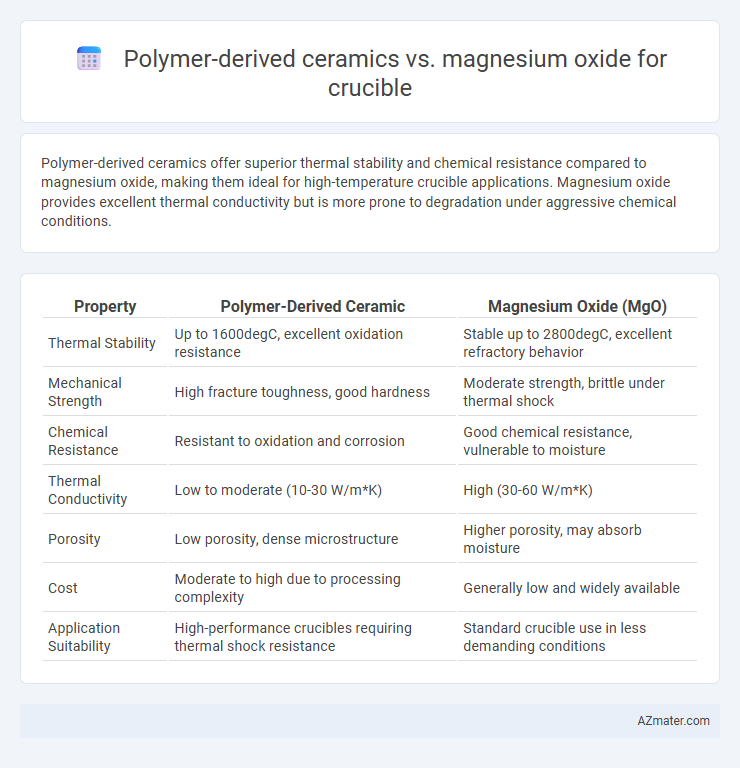Polymer-derived ceramics offer superior thermal stability and chemical resistance compared to magnesium oxide, making them ideal for high-temperature crucible applications. Magnesium oxide provides excellent thermal conductivity but is more prone to degradation under aggressive chemical conditions.
Table of Comparison
| Property | Polymer-Derived Ceramic | Magnesium Oxide (MgO) |
|---|---|---|
| Thermal Stability | Up to 1600degC, excellent oxidation resistance | Stable up to 2800degC, excellent refractory behavior |
| Mechanical Strength | High fracture toughness, good hardness | Moderate strength, brittle under thermal shock |
| Chemical Resistance | Resistant to oxidation and corrosion | Good chemical resistance, vulnerable to moisture |
| Thermal Conductivity | Low to moderate (10-30 W/m*K) | High (30-60 W/m*K) |
| Porosity | Low porosity, dense microstructure | Higher porosity, may absorb moisture |
| Cost | Moderate to high due to processing complexity | Generally low and widely available |
| Application Suitability | High-performance crucibles requiring thermal shock resistance | Standard crucible use in less demanding conditions |
Introduction to Crucible Materials
Polymer-derived ceramics (PDCs) offer superior thermal stability and chemical resistance compared to traditional magnesium oxide (MgO) crucibles, making them ideal for high-temperature applications exceeding 1600degC. MgO crucibles are widely used for their cost-effectiveness and good thermal conductivity but tend to suffer from degradation in aggressive environments due to their solubility in slags. The choice between polymer-derived ceramic and MgO crucibles depends on the specific requirements for thermal shock resistance, mechanical strength, and chemical inertness in metallurgical and advanced material processing.
Overview of Polymer-Derived Ceramics
Polymer-derived ceramics (PDCs) are advanced materials synthesized through the pyrolysis of preceramic polymers, offering exceptional thermal stability, chemical resistance, and structural integrity at high temperatures. Compared to traditional magnesium oxide crucibles, PDCs exhibit superior resistance to thermal shock and corrosion from aggressive molten metals and slags. Their tunable microstructure and composition enable tailored properties for specific high-temperature applications, making them highly versatile in demanding industrial environments.
Properties of Magnesium Oxide Crucibles
Magnesium oxide crucibles exhibit exceptional thermal conductivity and high melting point around 2852degC, making them ideal for high-temperature applications. They possess excellent chemical stability and resistance to slag attacks, ensuring durability in aggressive environments typical in metal casting and ceramic processing. Compared to polymer-derived ceramics, magnesium oxide crucibles offer superior thermal shock resistance and cost-effectiveness for industrial crucible usage.
Thermal Stability Comparison
Polymer-derived ceramics exhibit exceptional thermal stability, maintaining structural integrity at temperatures exceeding 1600degC, which surpasses the typical thermal limit of magnesium oxide crucibles around 2800degC in terms of phase stability but can suffer from oxidation at high temperatures. Magnesium oxide crucibles offer excellent thermal conductivity and resistance to thermal shock, making them suitable for high-temperature applications up to 2800degC but they can degrade under conditions of prolonged exposure to moisture or carbon-containing environments. The choice between polymer-derived ceramics and magnesium oxide depends on specific furnace conditions, with polymer-derived ceramics favored for oxidation-resistant and complex shape requirements, while magnesium oxide excels in conventional high-temperature, non-oxidizing environments.
Chemical Resistance and Reactivity
Polymer-derived ceramics exhibit superior chemical resistance and lower reactivity compared to magnesium oxide crucibles, particularly in aggressive environments involving acids and molten metals. Their amorphous or nanocrystalline microstructure minimizes degradation and contamination risks, enhancing durability during high-temperature reactions. Magnesium oxide crucibles, while cost-effective, are more prone to chemical attack and dissolution in acidic or basic melts, limiting their lifespan and purity retention.
Mechanical Strength and Durability
Polymer-derived ceramics exhibit superior mechanical strength and enhanced durability compared to magnesium oxide crucibles, due to their dense microstructure and high-temperature stability. These ceramics maintain structural integrity under thermal shock and corrosive environments, outperforming magnesium oxide which is prone to cracking and degradation over time. Consequently, polymer-derived ceramic crucibles offer extended service life and improved resistance to mechanical stress in high-temperature applications.
Cost and Manufacturing Considerations
Polymer-derived ceramic crucibles offer superior thermal stability and resistance to chemical corrosion but typically come at a higher cost due to complex precursor materials and specialized manufacturing processes. Magnesium oxide crucibles are more cost-effective, benefiting from abundant raw materials and simpler production methods, making them suitable for large-scale, budget-conscious applications. Manufacturing polymer-derived ceramics requires controlled pyrolysis and advanced equipment, whereas magnesium oxide crucibles rely on conventional sintering techniques, impacting overall production time and expense.
Applications in Laboratory and Industry
Polymer-derived ceramics offer superior thermal stability and chemical resistance compared to magnesium oxide, making them ideal for laboratory crucibles used in high-temperature chemical reactions and material synthesis. Magnesium oxide crucibles are widely employed in industrial settings for metal melting and calcination processes due to their excellent refractory properties and cost-effectiveness. Both materials serve critical roles in applications requiring high purity and durability, with polymer-derived ceramics preferred for advanced research and magnesium oxide favored in large-scale industrial operations.
Environmental and Safety Aspects
Polymer-derived ceramic crucibles exhibit superior thermal stability and chemical inertness, minimizing hazardous emissions during high-temperature processes compared to magnesium oxide, which can release harmful dust and degrade under thermal stress. The production of polymer-derived ceramics involves fewer toxic byproducts, enhancing workplace safety and reducing environmental pollution relative to MgO manufacturing. Their enhanced durability also lowers the frequency of replacement, contributing to reduced material waste and a smaller environmental footprint over time.
Conclusion: Choosing the Right Crucible Material
Polymer-derived ceramics offer superior thermal stability and chemical resistance compared to magnesium oxide, making them ideal for high-temperature and corrosive applications. Magnesium oxide crucibles, while cost-effective and exhibiting good thermal conductivity, may suffer from moisture sensitivity and lower mechanical strength. Selecting the right crucible material depends on specific operational requirements such as temperature range, chemical exposure, and durability needs.

Infographic: Polymer-derived ceramic vs Magnesium oxide for Crucible
 azmater.com
azmater.com